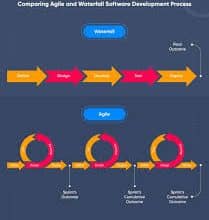Taking a cue from the post, 6 Easy Steps To Developing a Business Plan Outline, every business plan requires a financial projection to keep a tab on the growth of the company.
It is without dispute that the sole aim of every business is to make a profit. Basically, what a financial projection does is use existing or estimated financial data to forecast your business’ future income and expenses.
In this article, we have outlined the reasons why business financial projections are important, also presented detailed yet easy to follow ways to write financial projections for your business.
What is a Financial Projection?
Simply put, Financial Projection is the estimate of the future financial performance of a business.
Financial projections include scenarios that help you to view almost accurately how a change on a part of your business like an increase or decrease in sales can affect your profit-making capacity.
Business Financial projection is a very important aspect of the business plan. For instance, they are essential to creating feasible expectations for your finances and reducing the overwhelming nature of your business.
Get access to 500+ business plan with 3 years financial projections
Regardless of the use of the business plan, it is very essential you include both a long-term and short-term financial projection. This keeps you head-on in the same of surmounting business obstacles and making a profit.
Importance Of Business plan Financial Projections
The place of having a well-crafted financial projection in your business plan cannot be overemphasized.
It helps in the following ways;
Feasible Goals:
For start-ups, a business financial projection is important in your startup business plan to create and set feasible expectations and goals respectively.
Focus:
Business Financial Projections will help you monitor your goals, expand and still maintain the track.
Data Proof:
Business Financial Projections will serve as an evidence of conviction for your investors to see your business growth-ability when seeking external funding.
For instance, for businesses above 1 year, it helps to provide accurate data of your past performance to your investors.
Experiences that aid in Writing Financial Projections For Your Business.
Three most important experiences that can help you write your business financial Projections better are;
Company Experience:
Perhaps, you have gained experience in a similar business before you started yours. An ideal financial projection should now sprout from the experience you have gained.
Accounting Experience:
It is best to use an accountant who knows the gain, losses, pattern of sales the business may expect. The accountant can play a huge role in coming up with feasible Financial Projections.
There are management experts in Businessyield Consults who have gained ample experience over the years, they can help you with writing a detailed financial projection.
Research Experience:
The saying ‘nothing is new under the sun can be applied here. That is because every business model is an upgrade of an existing model of some sort.
Having established that, research will help this your new business model obtain accurate financial data from businesses that have overgrown the stage you are in. Compilation of accurate financial data is very necessary.
Simple Ways To Write Financial Projections for Your Business.
To write business Financial Projections, you make use of roughly calculated financial data (for startups) or already existing financial data to predict the income and expenditures for your business.
The financial section of your business plan includes the following information;
#1. Sales Speculations:
This requires the use of a spreadsheet to show your pattern of goods exchange over a period of 3-5 years.
In a spreadsheet otherwise known as excel, draft your sales for a period of 3 years.
You should include columns that show sales, prices, total sales (gotten from multiplying sales and profit). You will do this for every line o business you are involved in, monthly for at least the first three years.
This helps in forecasting long and short-term performances.
Meanwhile, for a start-up business, accurate sales rate prediction can help to make feasible business decisions.
#2. Prepare a production or output budget
This is likened to an expense budget.
How much will it take you to make the sales you have forecasted? If you want to take a loan how much will the interest be? What about taxes?
Will your production cost be covered by your sales price?
#3. Create a Cashflow Statement
This gives detailed data on cash inflows and outflows in your business. Furthermore, if it is a new business, the forecast should be based on sales forecasts, balance sheet items, and other assumptions.
For an existing business, you should have profit and loss statements and balance sheets from years past to base these forecasts on.
It is important you note that when compiling this cash-flow projection, you need to choose a realistic ratio for how many of your sales and purchases will be paid in cash. You can choose 30 days, 60 days, 90 days and so on.
#4. Income forecast
This is your profit and loss account (proforma, that is, projected or forecasted). The main thing you derive here is your net profit or loss.
The data required are your sales, expenses, and cash flow.
To arrive at the net profit or loss, Sales – Cost of sales(opening inventory+purchases – closing inventory) = Gross profit. Gross profit – expenses-interests-taxes = Net profit/loss.
See Also: The Hidden Sales Secrets that Increase Profit
#5. Forecast Assets, liabilities, and retained earnings
Assets and liabilities are contained in the balance sheet. The balance sheet basically shows the worth of your business at the end of that period it was written.
To do this, compile the assets; tangible and intangible assets, for instance, building, equipment, goodwill, etc you have at start-up. Afterward, estimate the monthly cash at hand, accounts receivable (money owed to you from credit sales), accounts payable (the one you are owing either from credit purchases), and debts and loans.
#6.Breakeven analysis
Breakeven occurs when your expenses and your income tally.
The three-year income projection will enable you to undertake this analysis. Perhaps, you are running at a profit or a loss.
Read More: 500+ business plans with 3years financial projections
For every viable business, there must be a period when your overall revenue will exceed your overall expenses, including interest.
Investors take this analysis very seriously because they want to invest in a fast-growing business with an exit strategy.
In conclusion, after writing the financial projections, do not revisit it once a year. It is meant to be a guide to track your daily, weekly, monthly, quarterly, and yearly financial progress. Use it as it is ought to and readjust accordingly as the business grows. Cheers to your business growth.
How do you write a financial projection for a business plan?
Here are the steps to create your financial projections for your start-up.
- Project your spending and sales. …
- Create financial projections. …
- Determine your financial needs. …
- Use the projections for planning. …
- Plan for contingencies. …
- Monitor.
What should financial projections in a business plan do?
Your financial projections should include three core financial statements – the income statement, the cash flow statement, and the balance sheet.
How do you calculate financial projections?
- Projected revenue = projected income – projected expenses.
- $60,000 – $5,000 = $55,000 in projected revenue.
- (7,000 – 5,000)/5,000 * 100) = 40% increase in sales.
- For other years that you wish to calculate, simply change the cell numbers accordingly.
What are the 7 components of a financial plan?
A good financial plan contains seven key components:
- Budgeting and taxes.
- Managing liquidity, or ready access to cash.
- Financing large purchases.
- Managing your risk.
- Investing your money.
- Planning for retirement and the transfer of your wealth.
- Communication and record keeping.
Financial Projections FAQ
What should a financial projection include?
- 1. Sales Speculations:
- 2. Prepare a production or output budget
- 3. Create a Cashflow Statement
- 4. Income forecast
- 5. Forecast Assets, liabilities, and retained earnings
- 6.Breakeven analysis
Why is financial projection important?
Business Financial projection is a very important aspect of the business plan. For instance, they are essential to creating feasible expectations for your finances and reducing the overwhelming nature of your business.
Related Article






